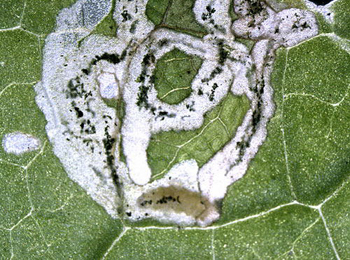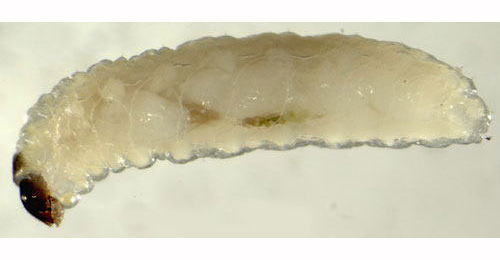|
||||||
|
ARABIDOPSIS. Thale Cress. [Brassicaceae] |
|
Three species of Arabidopsis, including the native Thale Cress (A. thaliana), are recorded in Britain. Arabis arenosa is treated as Arabidopsis arenosa by Stace (2010). The BSBI provide a downloadable plant crib for Brassicaceae. Four British miners are recorded on Arabidopsis. A key to the European miners recorded on Arabidopsis is provided in Bladmineerders van Europa. |
Key for the identification of the known mines of British |
||||||||||||||||||
1a > Leaf-miner: Rather small, untidy, full depth, often branched corridor, often close to the leaf margin. Sides irregularly eaten out. Frass in a greyish-green central line that is interrupted from time to time, sometimes partly in strings. In times of rain the frass may run out and appear greenish. Usually several mines in a leaf. The body is whitish; head greyish brown with Y-shaped lighter marking. Pronotum with a pair of brownish shields. The mandibles have two teeth. |
||||||||||||||||||
 Mine of Ceutorhynchus minutus on Raphanus sativus Image: © Willem Ellis (Bladmineerders van Europa) |
||||||||||||||||||
 Ceutorhynchus minutus larva, lateral Image: © Willem Ellis (Bladmineerders van Europa) |
||||||||||||||||||
|
||||||||||||||||||
Ceutorhynchus minutus (Reich, 1797) [Coleoptera: Curculionidae]. |
||||||||||||||||||
1b > Leaf-miner: Corridor-blotch mine, normally dorsal; usually whitish; in small leaves it lies characteristically in the centre of the leaf often touching the petiole; in larger leaves it lies to one side of the mid-rib. Frass deposited in green clumps near the leaf margin. Pupation usually external, sometimes in a separate pupation mine. Oviposition whitin the leaf, at the lower surface. The first part of the mine is a long, sometimes very long, corridor, that mostly will be overrun by the later developments. Generally this corridor is directed, frequently guided by a thick vein, to the midrib. The next section of the mine is large, irregular blotch overlying the basal section of the midrib. Locally large chunks of midrib tissue are consumed. From this central blotch excursions are made into the leaf blade: generally upper-surface, less often lower-surface and locally full-depth. In plants with narrow leaves, like Diplotaxis, the mine may occupy the entire width of the leaf. Often several larvae together in a mine. Frass blackish green, powdery, in clouds, sometimes along the sides of the corridors, later more in the periphery of the mine and in the end of extensions of the blotch, sometimes seemingly absent. (Often the frass can only be seen after the mine has been opened). Pupation generally in the ground, rarely within he leaf, in a short mine without frass. Hendel (1928a) described the biology, larva and puparium. An initial narrow gallery then leads to a blotch on the midrib of the leaf. Watch a video of a scaptomyzid fly larva on Arabidopsis on YouTube by mash92587. |
||||||||||||||||||
|
||||||||||||||||||
Scaptomyza flava (Fallén, 1823) [Diptera: Drosophilidae]. |
||||||||||||||||||
1c > Leaf-miner: A distinctive mine primarily above mid-rib, with irregular short lateral offshoots into leaf blade. Pupation external (Spencer, 1972: 51 (fig. 172), 55; Spencer, 1976: 270, 271 (fig. 486)). Branched, whitish, upper-surface corridor; main axis overlying the midrib; side branches overlying the main lateral veins. (In Campanula and Phyteuma the mine is much less branched, sometimes nothing more than a corridor on top of the midrib). Frass in rather long strings. Usually the mines begins as a long and narrow, shallow, tortuous lower-surface corridor that ends upon the midrib but otherwise is not associated with the leaf venation. Often this initial corridor is filled with callus, and then even less conspicuous. Pupation outside the mine. A linear mine on the upper surface, usually following the midrib and showing side branches along the veins. The frass is in strings. |
||||||||||||||||||
|
||||||||||||||||||

